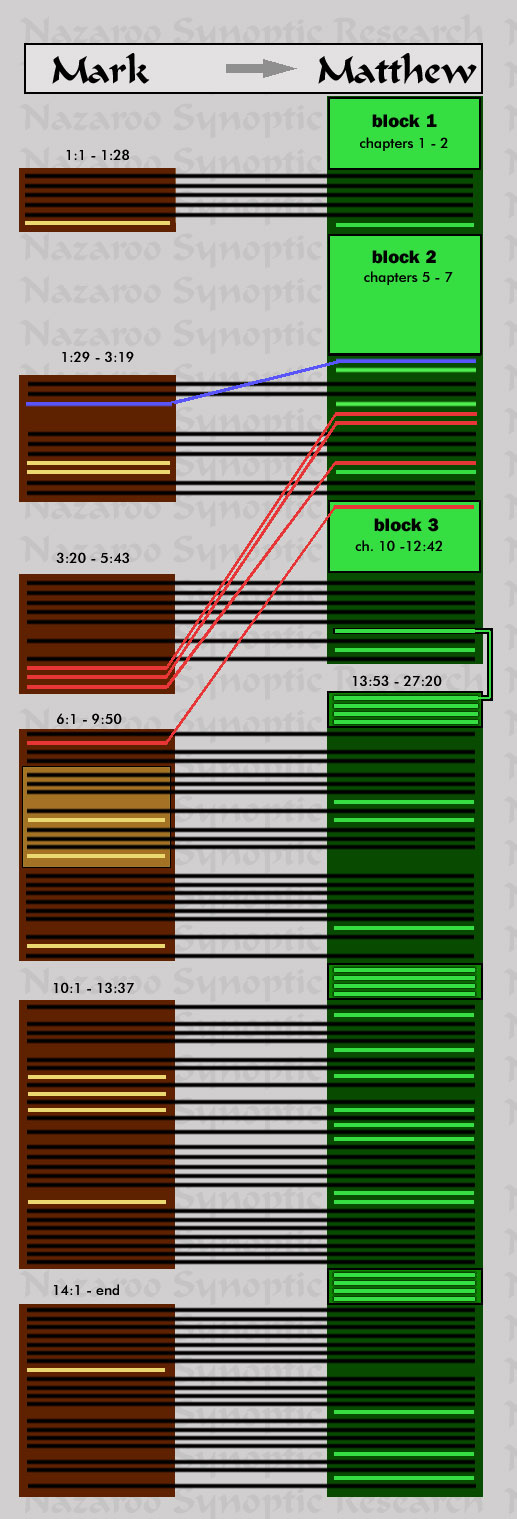Page Index
Last Updated: Sept. 16, 2007
Section 1: - Introduction to the Synoptic Problem
Section 2: - Matthew Uses Mark
Mark as a Base - block copying by Matthew
Sections Copied - additions, omissions, substitutions
Minor Changes - additions, omissions, substitutions
Rearrangments / Dislocations - chronological transpositions
The Big Picture - The full chart for Mark/Matthew
INTRODUCTION
The "Synoptic Problem" and Matthew
When all the arguments are considered, and the only seriously proposed alternative is the Priority of Matthew, we can see why Markan Priority is considered well established.
The evidence for Priority of Matthew is essentially 'external': that is, vague historical testimonies and claims by early Christian and other writers. However, some of this evidence cannot be shown to actually support the version of Matthew that we have now (in Greek).
It is easy to suppose a Hebrew (or Aramaic) "Matthew" with much of the content of the Greek Matthew, that would make sense of the early testimony about a 'Hebrew Matthew' without needing to assume that such a document is identical to our Greek Matthew.
On the contrary, it appears that the Greek Matthew (our canonical Matthew) is based on Luke, in spite of some minor 'counter-evidence' .
Disputing Markan Priority Doesn't Save Matthew
Although placing Matthew last in the chain also creates some problems concerning Matthew's agenda, these have plausible motivations in terms of the historical situation, and more importantly, the relative priority of Matthew to Luke does not affect the case for Markan priority.
Finally, although Matthew's purposes are problematic, there are counter-considerations that make Matthew's actions plausible and justifiable. But there would be no convincing purpose or need that we could assign for Mark if we placed him after Luke and Matthew.
Looked at another way, the same reasons by which we could explain Mark as copying Luke would also explain Matthew copying Luke. If Mark were producing a 'less controversial' gospel in terms of Luke's "social gospel", then we should assign the same purpose to Matthew, and even more convincingly.
And if Mark were producing a "Reader's Digest" gospel out of Matthew or Luke, then he did a lousy job of it, making a bloated and de-focussed account out of something grand (Matt. or Luke).
Thus putting Mark last does not 'save' Matthew from the same charges of 'editing out the social gospel' that Mark would face, or make more convincing Matthean Priority. If Mark had done this, then all the more reason to believe Matthew would have acted similarly.
Tentative Chronology: Mark --> Luke --> Matthew.
But there is a better solution available that does not strain credulity, and which takes into account new internal evidence regarding the dependancy of (Greek) Matthew upon Luke.
This leaves all three gospel writers addressing real historical needs, and leaves their motivations and integrity more or less intact.
Luke copied Mark, incorporating new and important material and a uniquely high vision of the gospel, based upon his experience with the early Church (the social gospel is experienced, learned, and shared!).
Matthew copied Mark and used Luke, rearranging the material for his vision of Jesus as the new 'Moses', editing it for public worship, avoiding potential clashes with Roman and Jewish authorities. Matthew also forges together the previous visions of James and Paul to provide a new unity of vision for the Church, and avoid heresy and schism.
We will examine these details shortly.
In both cases, real needs were addressed and a new vision was granted the early Church.
Luke shows us how to apply the gospel of love in real terms as a social gospel. He takes the experience of love in the early church and its manifestation as personal responsibility to one's brother/neighbour and the poor, and carries it to the whole world.
Matthew shows us how to understand Jesus as the Prophet that Moses foresaw, and how the Law (Torah) can be amplified and honoured, by melding together Jesus, Paul and James, removing the main stumbling-block to the Gospel for Jews of the diaspora, and ending petty disputes within the Church.
Matthew Uses Mark
Matthew also uses Mark as a Base
In analyzing Matthew, we find a very similar situation to Luke, and even simpler:
Matthew also uses Mark as a base, breaks it up into relatively few pieces, and inserts his material in bulk in three large blocks (in slightly different places than Luke inserts his). In addition however, Matthew also inserts several small sections each made up of four parables or pericopes.
Matthew's Block Outline
Matthew uses Mark in a very straightforward way:
| Matthew's Block Outline | |
|---|---|
| Matt. block 1: | Matt. 1 - 2 (Nativity & Genealogy etc.) |
| Mark block 1: | Mark ch 1:1 - 1:28 (short section) |
| Matt. block 2: | Matt. 5 - 7 (Sermon on the Mount etc.) |
| Mark block 2: | Mark 1:29 - 3:19 (keeping order closely) |
| Matt. block 3: | Matt. 10:1 - 12:42 (two-chapter block) |
| Mark block 3: | Mark 3:20 - end (with 3 four-section inserts) |
Block Copying
The phenomonon of 'block-copying' again indicates either one or the other of the Evangelists directly used the other, in a very simple and straightforward manner.
Once again, however, we can be fairly confident about the direction of the dependance, because many of the same arguments and evidence that explain the direction of dependance between Mark and Luke also apply to Mark and Matthew.
The main argument is that it is obvious what Matthew's purpose is in expanding Mark, but there is no adequate explanation for what Mark would have been doing if he wrote after Matthew (or Luke), and used him as a base.
Synoptic Chart of Mark / Matthew
Here we have laid out the basic relationship in a standard synoptic chart form:
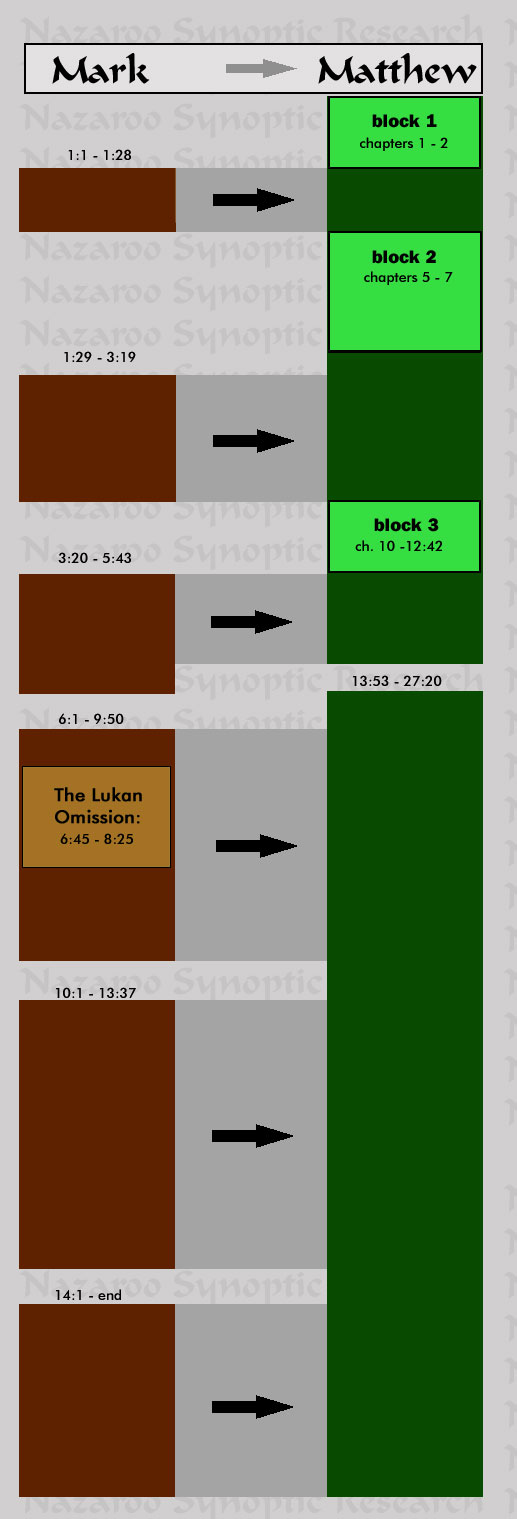
The 'Lukan Omission'
We have also shown the section that Luke omitted in making his own outline. It is clear from Matthew's result that he had this section before him and treated it like every other section of Mark.
Although Matthew makes some insertions and does some minor editing to the section, his method here is no different than his treatment of the rest of Mark. Nor does he dislocate its contents to another place. This clearly shows that Matthew found the section in its normal place and left it there.
Matthew Uses the Lukan Blueprint
One thing rather apparent, is that Matthew and Luke both use the same basic approach. Each inserts 3 large blocks of material, but keep the Markan material more or less together, and use it to form the backbone of their gospels. This is why both Luke and Matthew agree strongly with Mark's order of events, even though they differ drastically between themselves (we will see this later when we compare Matthew and Luke).
Matthew makes some modifications to Luke's plan however. He places the Genealogy at the beginning, in his First Block. This is an organizational choice, since its not part of the chronology.
Matthew's First Block is also a set of Nativity stories, however, there is no real overlap. This Nativity theme is no coincidence however, and shows an awareness of Luke's comparable section. Clearly both Luke and Matthew are meeting a real need, that is inquiries about the origin of Jesus. At the same time, Matthew is not replacing or superceding Luke's account, but supplimenting and expanding it. Right from the start then, there is strong evidence that one of the two knows the other, and that their goals are not competing, exclusive, or incompatible.
Matthew also inserts his Second Block (The Sermon on the Mount, Matt. ch. 5 - 7) closer to the beginning of Jesus' ministry, and has enlarged Luke's original "Sermon on the Plain" (Luke 6:20-49) significantly.
Whether one regards these as two separate literal events, or literary 'versions' of the same essential event, it is clear that Matthew knows of Luke's version, and intends his own as an 'alternate' super-sermon, meant to capture a large essence of Jesus' teaching, and perform the same function as Luke's speech does in Luke. There are significant differences in Matthew's expansion, but interestingly, a large part of Matthew's added material is actually drawn from other parts of Luke.
Matthew's Third Section is likewise a large body of Teaching from Jesus, and drawn at least in part from either Luke or the same source that Luke used (Some have called this hypothetical source "Q").
Everything we see in Matthew is consistent with his awareness of both Mark and Luke, and his respect for both previous evangelists. The key observations here are that Matthew 'semi-independantly' uses Mark as a base just like Luke does. Both Luke and Matthew expand Mark with important supplimental material (much of it the same, or similar), and at least one of them shows an awareness of the other's methods. Finally, Luke and Matthew are not simple competators, but probably Luke is unaware of Matthew, while Matthew does not intend to directly supercede Luke's gospel.
Instead, Matthew gives both Mark and Luke respect, using one (Mark) as a basic outline, and the other (Luke) as a methodological blueprint and source for many stories and sayings.
Mark --> Matthew
Sections Copied
Here we show with the black horizontal lines, each of the sections that Matthew copies over from Mark. Matthew copies about 60 of 72 sections, near verbatum, and only leaves out about a dozen (see below).
We can see the basic plan by just looking at pericopes that Matthew copies straight over.
Matthew appears to use less of Mark than Luke, but in fact a few sections of Mark have been moved to other locations. Other sections have been replaced by suitable substitutions. (see below).
These are the sections that are left pretty much as is, and in the same order that Mark gave them:
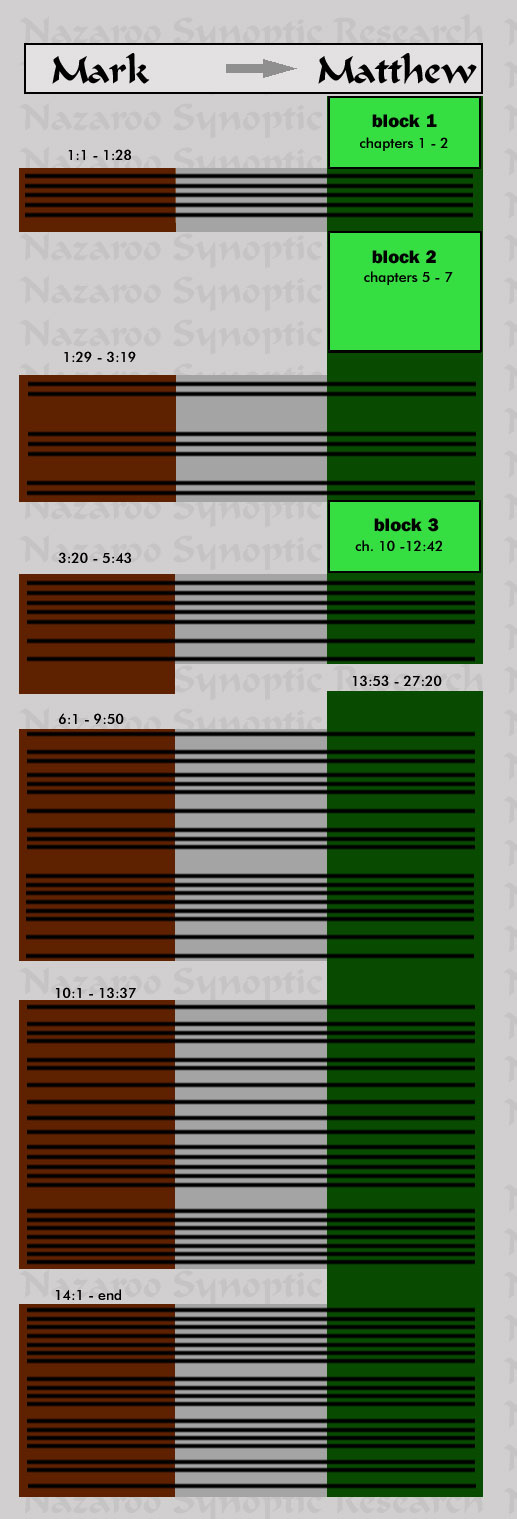
Minor Additions,
Omissions, Substitutions
Now lets look at Luke's use of Mark in a little more detail:
Main Lines,
Minor Add. Om. Subst.
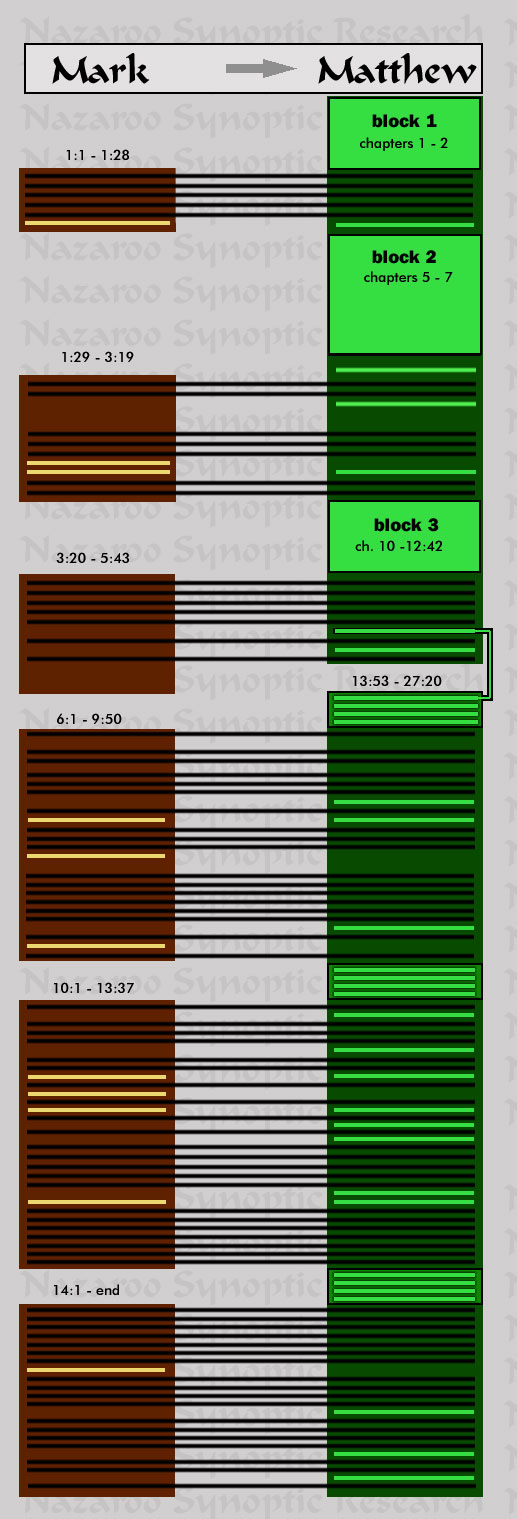
Mark --> Matthew: Omissions
Next we can look at those sections in Mark that Matthew omits (in yellow), and the new sections that Matthew adds (in bright green).
Matthew does make many more substitutions and additions than Luke, another indication of a continuing process in gospel metamorphosis.
Again as in Luke's case, a great many of these substitutions are easily understood as retellings, summaries, and generalizations meant to give a better overview of Jesus' ministry.
The demon cast out in Mark 1:21-28 is replaced with a general description of such incidents in Matthew 4:23-25. This makes for a better summary of events leading up to the next section, the Sermon on the Mount.
A leper's cleansing (Mark 1:40-45) and healing for a Centurion's servant (Luke 7:1-10) is grouped and used as an intro to the next section of events and miracles. At the same time, the Lukan story is adjusted to remove a potential controversy.
A pep-talk on the cost of discipleship is inserted (Matt. 8:18-22), and combined with Jesus' controlling the weather and the healing of the demon-possessed man.
The reference to "LEGION" is quietly removed, to avoid any dangerous allegorical interpretation of the incident that would apply it to the Roman Occupation of Palestine (Matt. 8:27-31 compare the original: Mark 5:1-20...)
The dispute over the shewbread, which involves difficulties for disputing with Jews is dropped (Mark 2:23-28), perhaps due to Jewish polemics.
Another particular healing is dropped (Mark 3:1-6). Matthew prefers summaries and generalizations for these incidents. In its place he inserts a quick note of two blind-man healings.
Mark --> Matthew: Insertions
Matthew expands the call of the Twelve Apostles (Mark 3:13-19) and uses it as a starting-point for his large Third Block of material (Matt. 10:1-12:42).
Further down he begins inserting a few Parables and discussions:
Parable of "Wheat & Weeds" - Matt. 13:24-29
Parable of the Leaven Matt. 13:33
and finally a block of four:
Parable of Wheat & Weeds explained (Matt. 13:36-43)
Parable of Hidden Treasure (Matt. 13:44)
Parable of Pearl of Great Price (Matt. 13:45-46)
Parable of the Dragnet (Matt. 13:47-52)
This uniquely Matthean material seems rather less exciting and of a different quality than the parables of Luke, and probably indicate something of Matthew's unique talent and viewpoint.
Although Matthew reproduces the remarkable 'Lukan Omission' (Mark 6:45-8:25), he edits it and injects it with some uniquely Matthean material (another explanation of the 'Wheat & Weeds? - Matt. 15:12-13) and a reference to the 'blind leading the blind' (Matt. 15:14 - John 9?)
Matthew also injects some teaching on fasting (Matt. 17:19-21), and a remarkable story about Jesus paying taxes! (Matt. 17:24-26). This appears to be early apologetic material and church teaching.
Then follows another block of four parables/teachings (Matt. 18:10-19:2)
Parable of the Lost Sheep (Matt. 18:10-14 = John 10:1-14?)
Dealing with a Sinning Brother (Matt. 18:15-20, from Paul?)
Parable of the Unforgiving Servant (Matt. 18:21-35, cf. Luke 12:57-59)
A Multitude Healed (6th time! Matt. 19:1-2)
Again, what appears to be a later church teaching on celibacy is inserted by Matthew (Matt. 19:11-12), which appears to be apologetic in purpose.
The Parable of the Vineyard Workers (Equal Pay question) (Matt. 20:1-16) is another story apparently motivated by church issues.
The Fig Tree story is retained but generalized and simplified (Matt. 21:18:22)
Then follows the parable of the Two Sons (Matt. 21:28-32) and the Parable of the Wedding Feast (Matt. 22:1-14), which appears to be a toned-down version of Luke's Parable of the Great Supper (Luke 14:15-24).
Matthew substitutes a Lamentation over Jerusalem (from Luke 19:41-44?) for the important story of the Widow's Penny (Mark 12:41-44) a clear piece of evidence that Matthew is systematically avoiding all of the Social Gospel material.
We will see later that Matthew deletes almost all the Social gospel material entirely, and its not simply because he 'didn't know of Luke's Gospel'. Examples like that above show Matthew knows Luke's material quite well, but deliberately removes it.
The reason is probably not because he is hostile to this teaching, but that his purpose is to compose a gospel for Public Reading that will pass the scrutiny of non-Christian listeners and spies.
Matthew also inserts another four parables, and this pattern seems to indicate he has a document containing a list of perhaps a dozen, that are all unique to his sources, or composed by himself.
Parable of the Faithful and Bad Servants (Matt. 24:45-51)
Parable of the Wise and Foolish Virgins (Matt. 25:1-13)
Parable of the Talents (Matt. 25:14-30)
Parable of the Sheep & Goats (Matt. 25:31-46)
Matthew also adds the story about the guards appointed over Jesus' grave, and the bribery by the Jewish authorities. (Matt. 27:62-66, 28:11-15).
Matthew skips the story of the young man fleeing naked (Mark 14:51-52), probably following the discretionary example of Luke.
For the rest, Matthew mostly inserts short glosses and makes minor improvements to the grammar and diction of Mark, but otherwise follows Mark rather closely in the sections where he relies upon Mark.
Mark --> Matthew
Dislocations
Next, we can look at the sections that Matthew rearranges. He does less shuffling than Luke does, and so we can put both minor and major dislocations on the same chart. This again indicates that Matthew is relying directly upon Mark rather than indirectly through Luke, for these sections, even though in his non-Markan sections he appears heavily dependant upon Luke in most cases.
There are a total of only five significant dislocations:
(1) Matthew pulls back the healing of the leper (Mark 1:40-45) to Matt. 8:1-4, to serve as an intro to his following section.
(2) He pulls back the Wind & Waves (Mk 4:35-41) to Matt. 8:23-27 and
(3) The Exorcism of "Legion" (Mk 5:1-20) to Matt. 8:27-31.
(4) The Bleeding Woman & Jairus' Daughter Raised (Mk 5:21-43) are also pulled back to Matt. 8:18:26.
(5) The Sending of the Disciples (Mk 6:6b-13) is combined with the Calling of the Twelve in Matt. 10:1-5a.
Matthew rearranges the Markan material very little, partly because there is no need. The bulk of the large dislocations in Matthew are really a rearrangement of Luke's material (mostly sayings and parables) and that is Matthew's real agenda.
Displacements in Matthew:
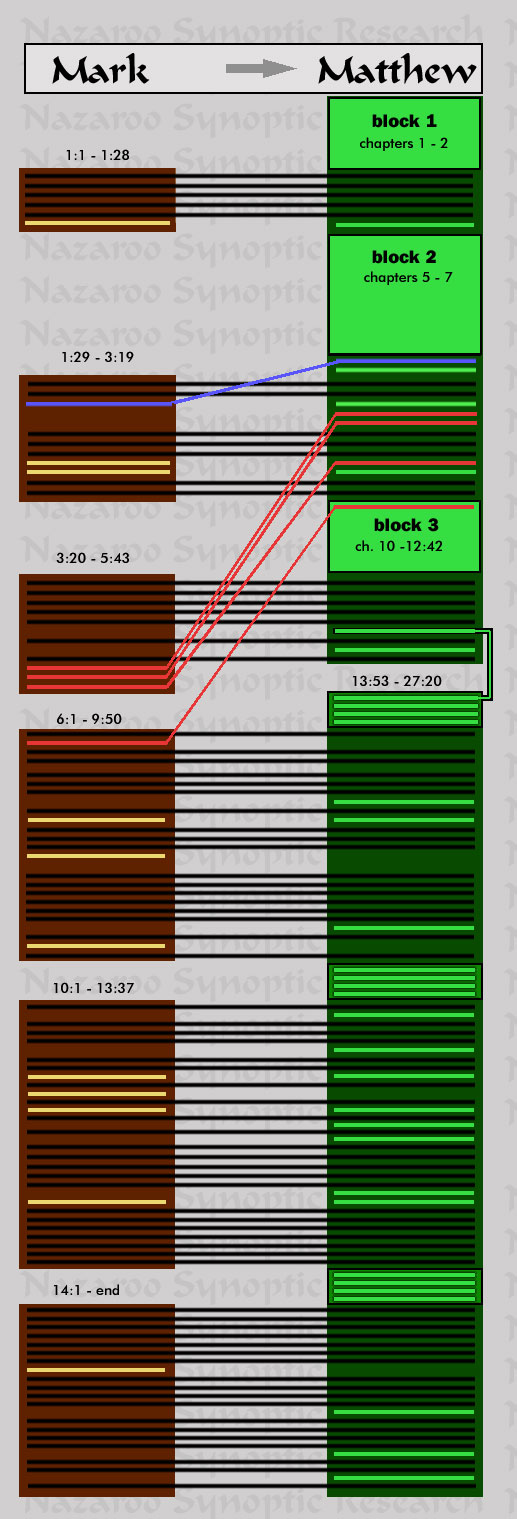
The Big Picture
Final Chart: Mark --> Matthew
For comparison purposes, we can add a light brown box around the section that Luke (see our page on Mark/Luke) omitted when copying Mark (Mark 6:45-8:25).
As noted, Matthew treats this section no differently than he treats every other section of Mark. This suggests that the section was found in the copy of Mark that Matthew used in composing his gospel.
If so, this would place the composition of Matthew somewhat later than Luke, as expected.
We will look at the evidence for relative dating between Luke and Matthew later, when we compare the two.
Here is the final chart for Mark / Matthew:
Mark and Luke: Overview
